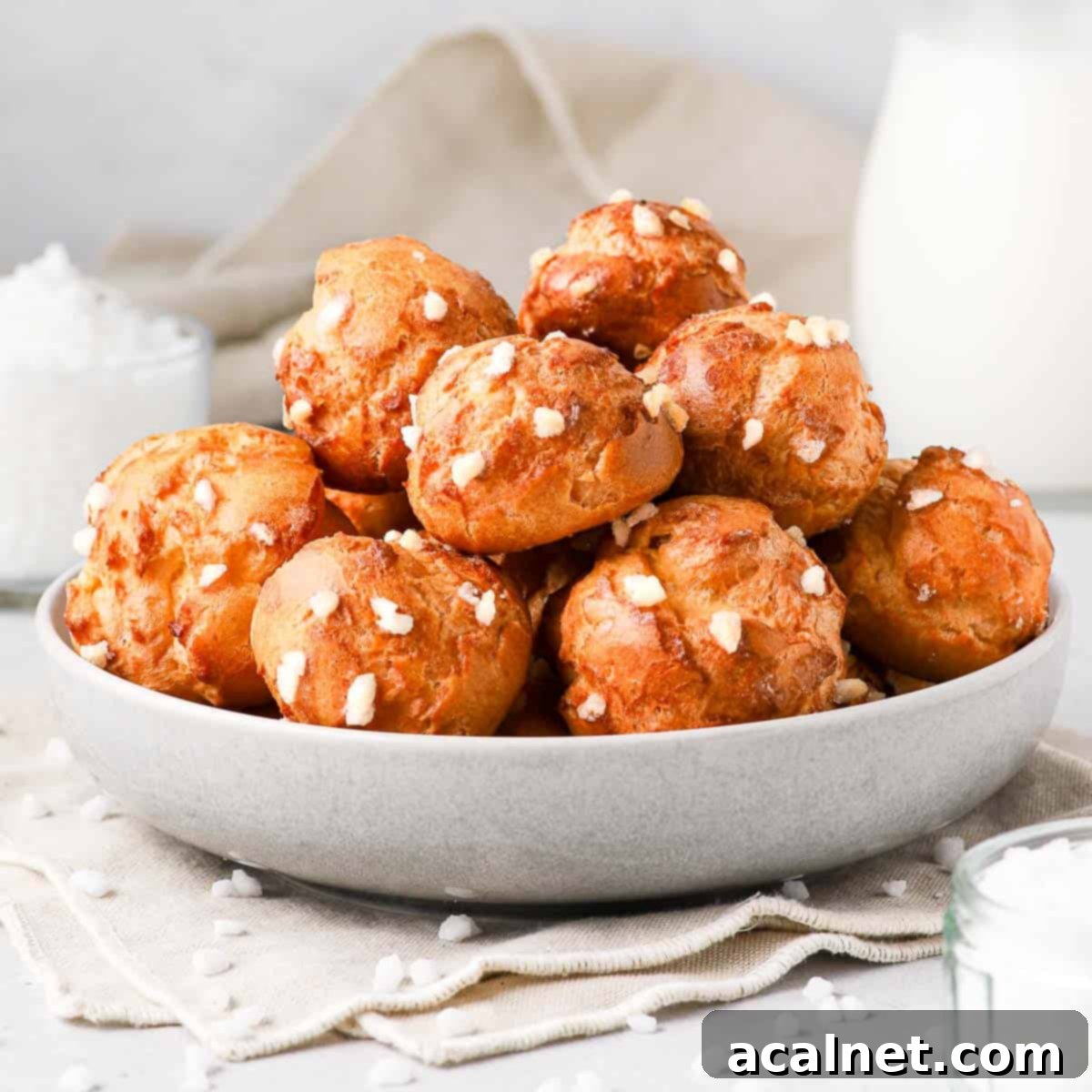Authentic French Chouquettes Recipe: Delightful Sugar Puffs for Every Occasion
Welcome to the enchanting world of French patisserie! These Chouquettes, also known as French Sugar Puffs, are a traditional and beloved sweet treat that encapsulate the charm of French baking. Often enjoyed during “le goûter” (afternoon tea), these light, airy choux buns, crowned with glistening pearl sugar, offer a delightful texture and a subtly sweet flavour. Whether savoured plain or decadently filled with cream, Chouquettes are a simple pleasure that transport you straight to a Parisian bakery with every bite.
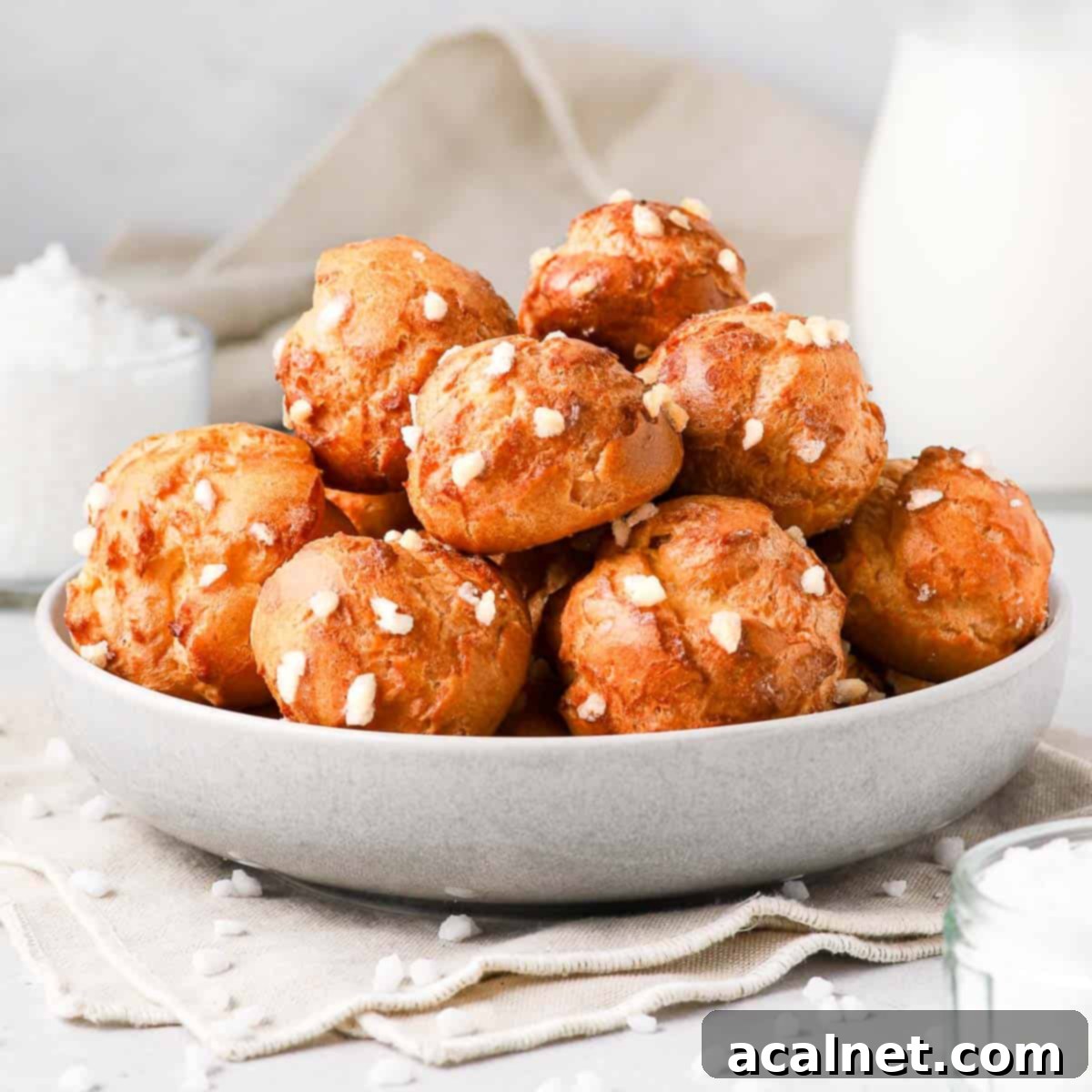
Why You’ll Adore This Chouquettes Recipe
Beyond renowned French desserts like Flan Pâtissier or delicate Financiers, Chouquettes hold a special place in the heart of French culinary tradition. You’ll discover these iconic treats in nearly every French bakery, a testament to their enduring popularity. They are truly the quintessential bite-sized indulgence for afternoon tea, known in France as “le goûter.” Each Chouquette is a masterclass in texture: incredibly light and airy within, perfectly contrasted by the satisfying crunch of their pearl sugar topping.
Crafted from the versatile and classic Choux Pastry dough (Pâte à Choux), the same foundation used for elegant Eclairs, delightful Profiteroles, luscious Choux à la Crème, rich Chocolate Choux Buns, or even the crispy Choux au Craquelin, these Chouquettes are surprisingly simple and quick to prepare. The best part? They’re even easier to eat – a testament to their irresistible nature. Trust us, you’ll find it hard to stop at just one, or even five!
Ready in under an hour, these French Sugar Puffs make an excellent after-school snack (many French university students, myself included, have fond memories of grabbing a bag from the local bakery). They are also a perfect addition to parties, holiday gatherings, or as a thoughtful, edible gift. Their effortless elegance and delightful taste make them a crowd-pleaser for any occasion.
What Exactly are Chouquettes?
Chouquettes (pronounced “shoo-kets“) are charming small choux puffs made from a versatile dough called Choux Pastry (Pâte à Choux). Their distinctive feature is a generous topping of crunchy Pearl Sugar. While most commonly sold plain in French bakeries, allowing the delicate flavour and texture of the choux to shine, they can also be transformed into a more indulgent treat by filling them with various creams. Popular choices include light and fluffy Whipped Cream, classic Chantilly Cream, or for an extra decadent experience, rich Crème Pâtissière (Pastry Cream) or Diplomat Cream (as featured in this recipe).
Interestingly, Chouquettes are often considered the sweet counterpart to Gougères. Gougères are savoury French cheese puffs, also made from Choux Pastry but mixed with grated cheese, highlighting the incredible versatility of this fundamental dough in French cuisine. This simple yet elegant French confection offers a delightful combination of textures – a crisp exterior giving way to a wonderfully hollow and tender interior, all enhanced by the sweet crunch of pearl sugar.
Essential Ingredients for Perfect Chouquettes
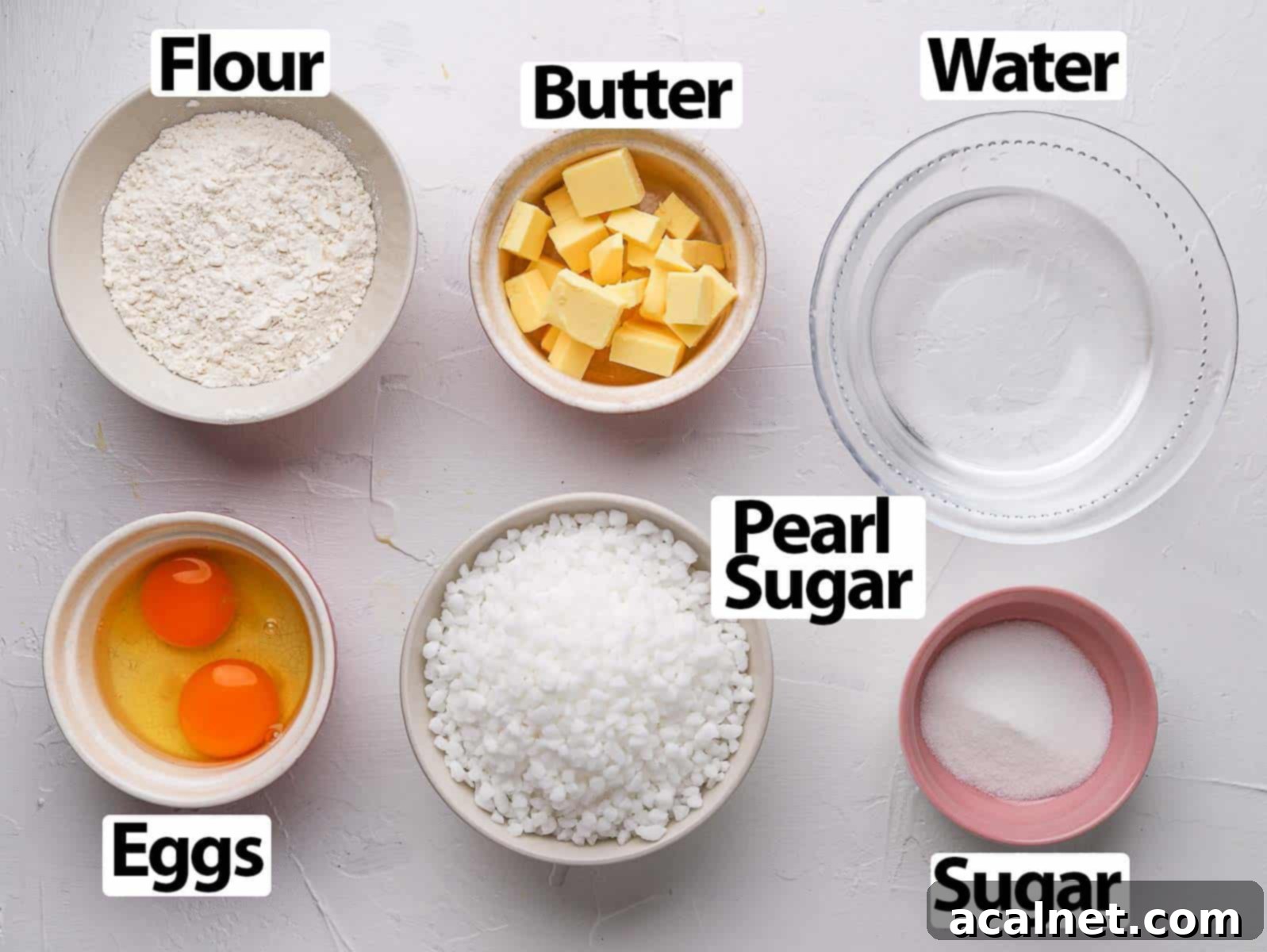
Crafting these delightful Sugar Puffs requires the fundamental components of classic Choux Pastry, with the delightful addition of Pearl Sugar for their signature finish. Here’s a detailed look at each ingredient:
- Water: While Choux Pastry can be made with milk or a combination of water and milk, using only water tends to result in a lighter, airier choux bun, which is ideal for Chouquettes. If you prefer a slightly richer flavour and a softer texture, you can certainly substitute the water with an equal amount of milk.
- Unsalted Butter: Always opt for unsalted butter when baking to have full control over the salt content in your recipe. Since the butter will be melted with the water, you can use it directly from the fridge without needing to soften it beforehand.
- Sugar (Caster or Fine Granulated): A small amount of caster sugar or fine white granulated sugar is added to the dough. Choux buns are not typically very sweet on their own; most of the sweetness for Chouquettes comes from the pearl sugar topping. This slight sweetness in the dough helps to balance the overall flavour.
- Plain or All-Purpose Flour: Sifting your flour is a crucial step to prevent lumps and ensure a smooth, uniform dough. This contributes to the delicate texture of the finished choux.
- Eggs (Room Temperature): Eggs are arguably the most critical and variable ingredient in choux pastry. Their exact quantity can fluctuate based on how thoroughly the initial dough (panade) was cooked on the stovetop (determining its dryness and evaporated water content), as well as the specific type and brand of flour used. Using room temperature eggs helps them incorporate more smoothly into the dough, creating a more consistent emulsion. Refer to the “Tips for Success” section for more guidance on egg quantity.
- Pearl Sugar: This is the star topping of Chouquettes. You’ll generally find two main types: Belgian Pearl Sugar, which is coarser and larger, and Swedish Pearl Sugar, which is smaller and slightly more delicate. Both varieties will work, but the smaller Swedish pearl sugar tends to adhere better and provide a more uniform crunch on the smaller choux puffs. This sugar provides the characteristic crispy, sweet shell.
While Pearl Sugar is the traditional and most common topping for Chouquettes, some variations do exist. Occasionally, you might find them adorned with mini Chocolate Chips for a different sweet twist, offering a slight bitterness to balance the sweetness.
For an extra treat, I’ve opted to fill these particular choux buns with a luscious Diplomat Cream. However, it’s essential to remember that Chouquettes are absolutely exquisite when served plain, allowing their inherent flavour and wonderful texture to be the star. The choice is yours!
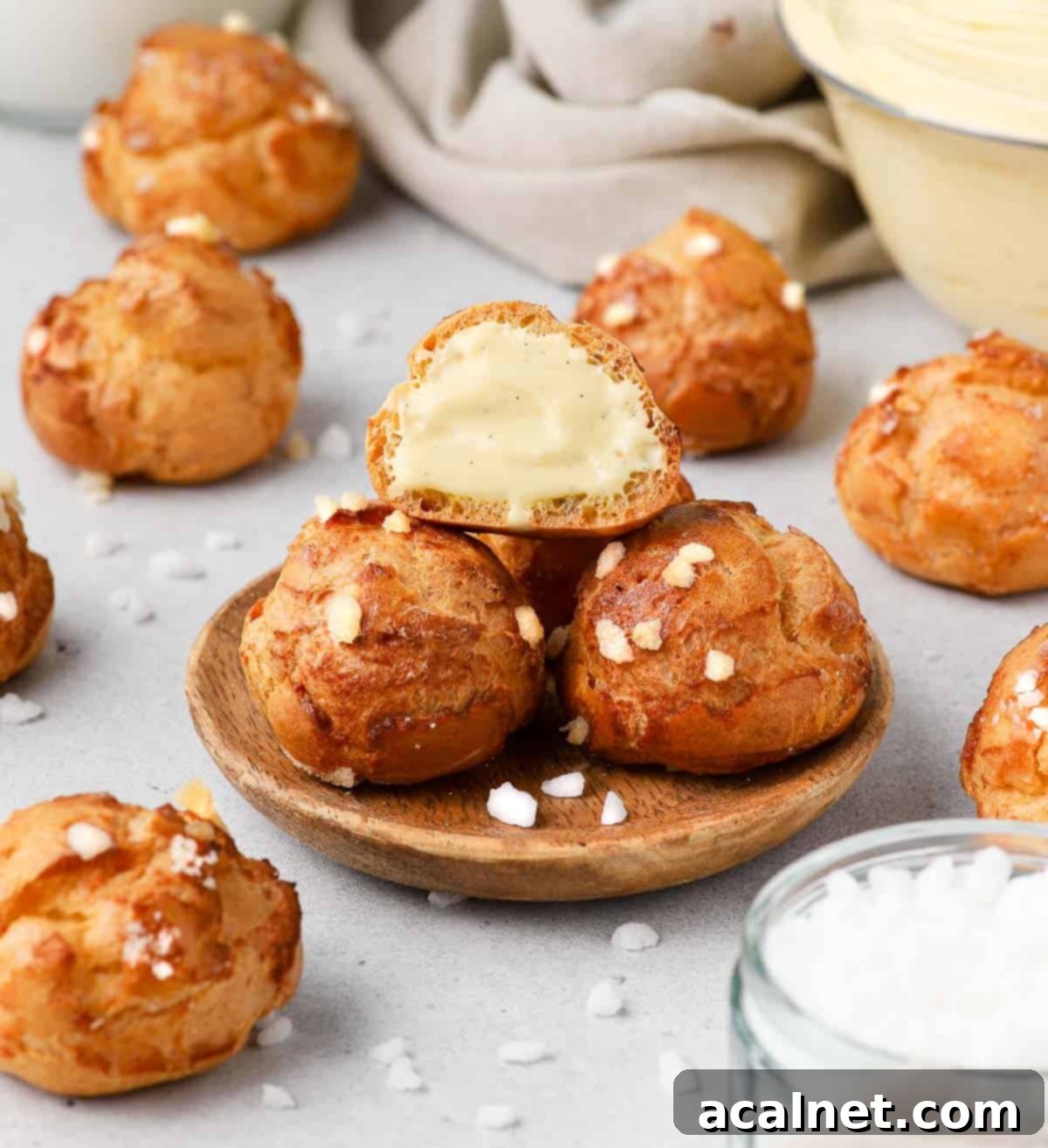
Mastering Chouquettes: A Step-by-Step Guide with Pearl Sugar
If you’re already familiar with making Choux Pastry, this chouquette recipe will feel like a comfortable journey. The process for making these French sugar puffs is essentially the same as any other choux pastry creation, focusing on precision and technique for the best results. Let’s dive into each step:
- Begin by meticulously weighing all your ingredients. This ensures accuracy, which is key in baking. Whisk your eggs in a separate small bowl; this makes it easier to incorporate them gradually later.
- Preheat your oven to 180°C (350°F). Prepare a large baking sheet by lining it with a baking mat or parchment paper. For superior results, especially if you frequently bake choux pastries or other delicate items, a Silpat (silicone mat) placed over a perforated tray is a worthwhile investment. The perforations allow for better air circulation, contributing to a crispier crust.
- Photo 1: Creating the Base: In a medium-sized saucepan, combine the water, butter, and sugar. Heat this mixture over medium heat, stirring gently until all the butter and sugar have completely dissolved. There’s no need for a rolling boil; a gentle simmer is perfectly sufficient to melt the butter and dissolve the sugar.
- Photo 2: Incorporating the Flour: Remove the saucepan from the heat immediately. Add the sifted flour all at once. Sifting is crucial here to prevent lumps and ensure a smooth dough.
- Photo 3: Forming the Dough: Using a sturdy wooden spoon or a stiff heat-resistant spatula, vigorously stir the mixture. Keep stirring until it comes together, forming a cohesive dough ball that pulls away from the sides of the saucepan.
- Photo 4: Drying out the Dough (The “Panade”): Return the saucepan to the stovetop, setting the heat to medium-low to medium. Continue stirring and pressing the dough against the sides of the pan for a few minutes. This crucial step, known as drying out the “panade” (the French term for the cooked choux dough base), removes excess moisture. The dough is ready when you observe a thin film forming at the bottom of the saucepan, and the dough no longer sticks to the pan. This dehydration is vital for ensuring your choux buns rise beautifully in the oven, creating that characteristic hollow interior. A good technique is to use a rotating movement with your spatula, pressing the dough firmly against the pan’s surface.
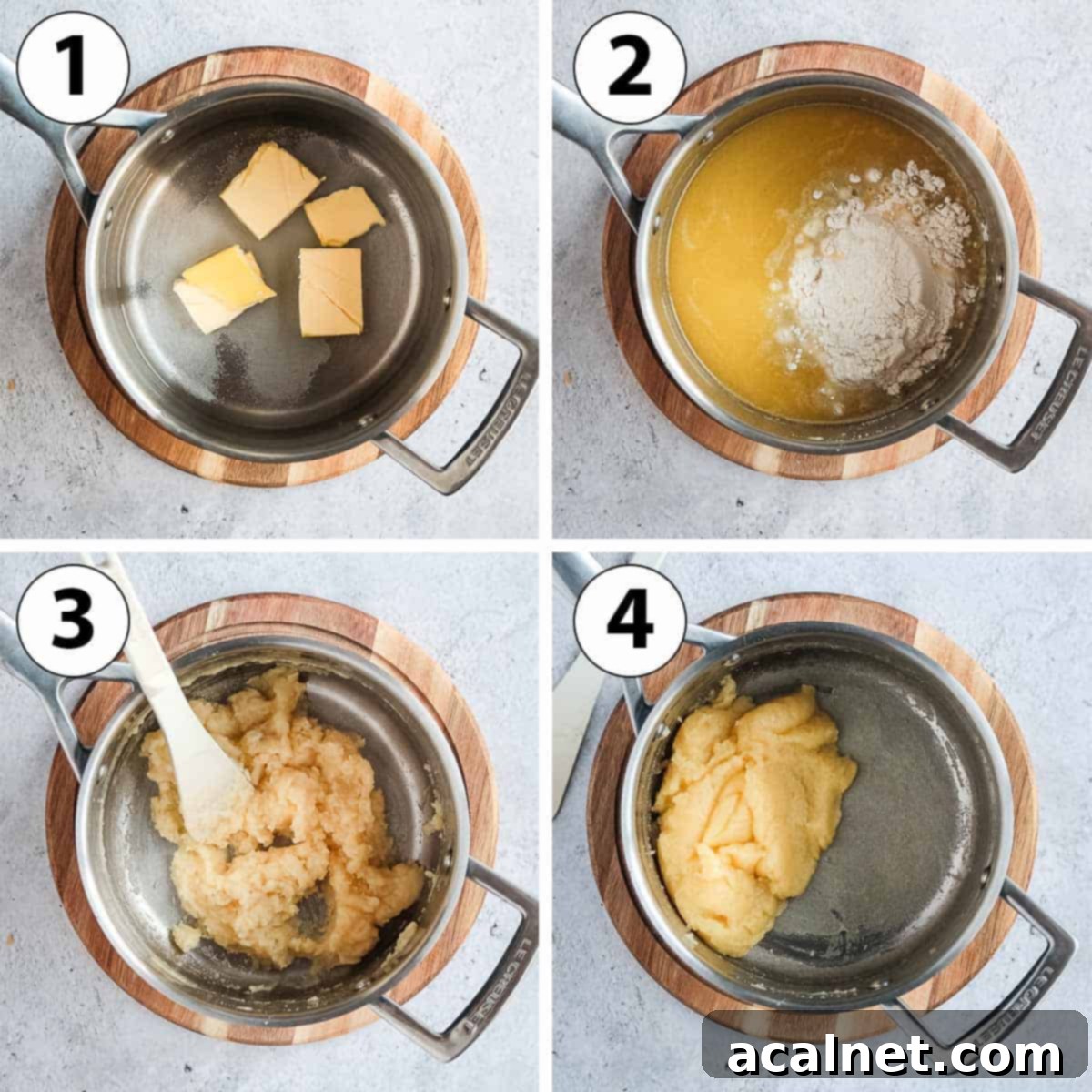
- Remove the panade from the stove and transfer it into the bowl of your stand mixer (if using, otherwise a large mixing bowl for hand mixing). Allow it to cool for about 10 minutes. This prevents the hot dough from cooking the eggs when they are added.
- Photo 5: Gradual Egg Incorporation: With the stand mixer fitted with the paddle attachment (or using a hand mixer or strong spoon), begin adding the pre-whisked eggs a little at a time. It’s perfectly normal for the dough to appear to separate or split each time you add eggs; simply continue mixing, and it will eventually come back together into a smooth, cohesive pastry.
- Photo 6: Achieving the Perfect Consistency: Continue adding the whisked eggs gradually until you achieve a soft, pliable, and shiny choux pastry. The exact amount of egg required can vary based on your flour and how much moisture evaporated during the stovetop cooking. To test for the correct consistency, poke a finger into the dough and lift it. A small amount of dough should stick to your finger. Turn your finger upside down; the dough should slowly fall back into an inverted ‘C’ or ‘beak’ shape. If it stands stiffly without falling, add a bit more egg. If it’s too liquid and collapses entirely, unfortunately, too much egg has been added, and the dough cannot be fully recovered.
- Photo 7: Piping the Puffs: Transfer the choux pastry into a pastry bag fitted with a large round piping tip (about 1-inch diameter). Pipe small, uniform mounds of pastry onto your prepared baking mat, leaving adequate space between each chouquette as they will expand considerably during baking. While some recipes suggest an egg wash, I’ve personally found it unnecessary for Chouquettes.
- Photo 8: The Pearl Sugar Topping: Generously sprinkle pearl sugar over each piped chouquette. Don’t be shy; the choux buns will puff up significantly in the oven, and some of the sugar may fall off. A good coating ensures that signature crispy texture and sweet appeal.
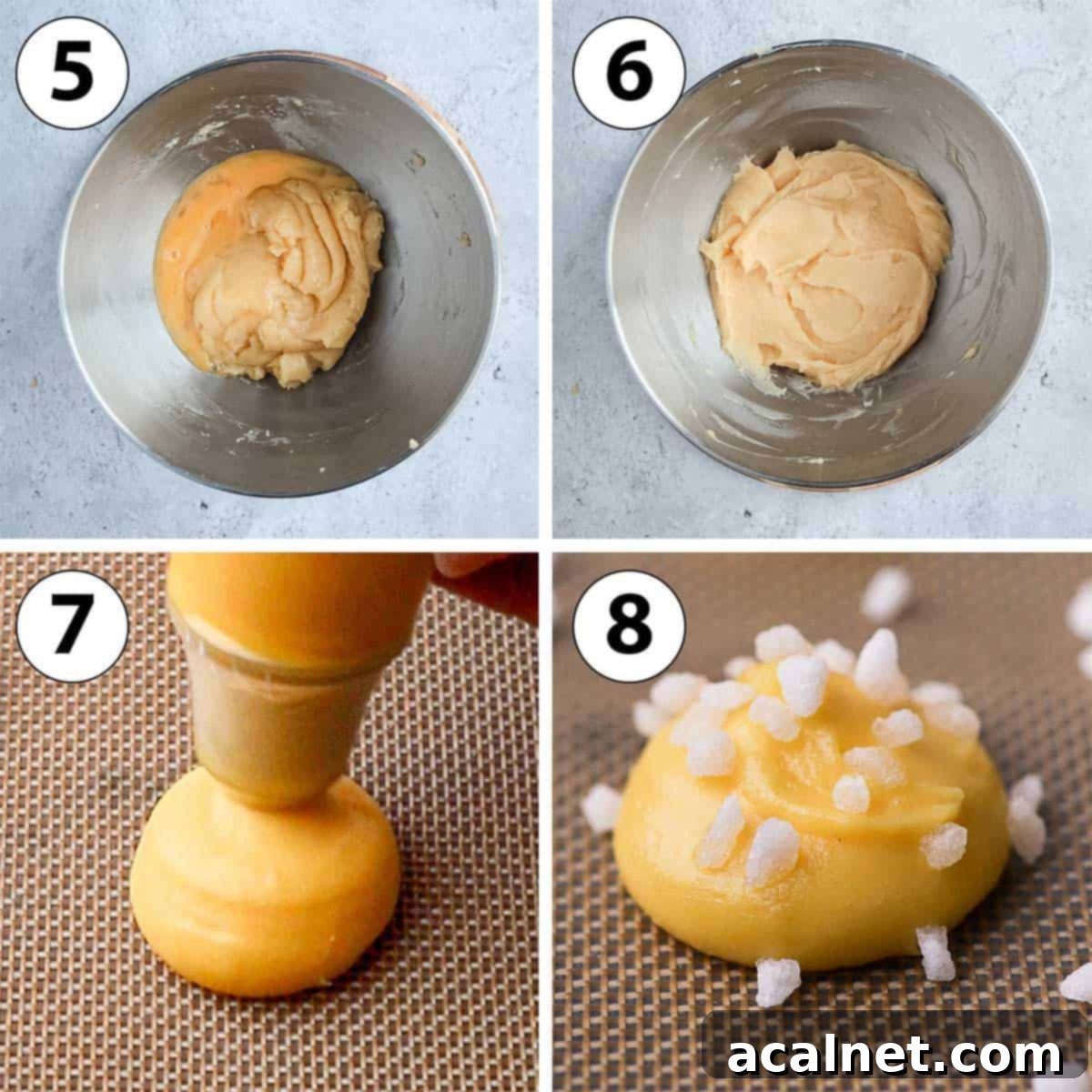
- Bake the Chouquettes for 25 minutes. After this initial period, quickly open the oven door for just a second to release accumulated steam, then close it immediately. Continue baking for an additional 10 to 15 minutes, or until the chouquettes are beautifully puffed, deeply golden brown, and feel light when lifted. Keep in mind that exact baking times can vary depending on the size of your chouquettes and the calibration of your oven.
- Once baked, remove them from the oven and allow them to cool completely on the baking sheet. Serve them immediately for the best texture and flavour. If you choose to fill them, do so just before serving. Here’s the Diplomat Cream recipe I used for a delightful filling.
Chouquettes Recipe FAQs
Pearl sugar, essentially small, irregular chunks of coarse sugar, is often available online or at specialty baking stores. If you’re having trouble locating it, you can even make your own pearl sugar from regular sugar cubes! There are several excellent tutorials available online, such as this one here, showing you how to do it.
While a pastry bag with a round tip provides the neatest and most uniform chouquettes, it’s not strictly necessary. I personally haven’t tried the popular ziplock bag trick for piping, but many bakers find success with it (simply snip a corner off a sturdy ziplock bag). Alternatively, a small ice cream scoop or even two spoons can be used to drop mounds of choux pastry onto the baking sheet, creating perfectly charming, albeit slightly more rustic, chouquettes.
Traditionally, Chouquettes are savored plain, allowing their delicate flavour and crispy texture to shine. However, they are incredibly versatile and can be filled with virtually any cream you desire! Popular choices include light and airy Whipped Cream, classic Chantilly Cream, rich Crème Pâtissière (Pastry Cream), or the elegant Diplomat Cream (which combines pastry cream and whipped cream, as used in this recipe). For chocolate lovers, a Chocolate Pastry Cream or even the coffee custard used in my Coffee Choux Buns would make fantastic fillings.
Achieving perfectly puffed and stable choux pastries relies on a few critical factors:
1. Thoroughly dry out the dough on the stove: This removes excess moisture, creating a strong structure for the steam to expand within.
2. Add eggs judiciously: Incorporate eggs gradually until the dough reaches the ideal consistency – not too stiff, not too runny. The exact quantity may vary.
3. Bake sufficiently and resist opening the oven door: Bake for longer than you might think necessary. The choux pastry needs ample time to form a sturdy crust. Only open the oven door once, briefly, during the baking process (typically towards the end) to release steam; frequent or early opening can cause them to collapse.
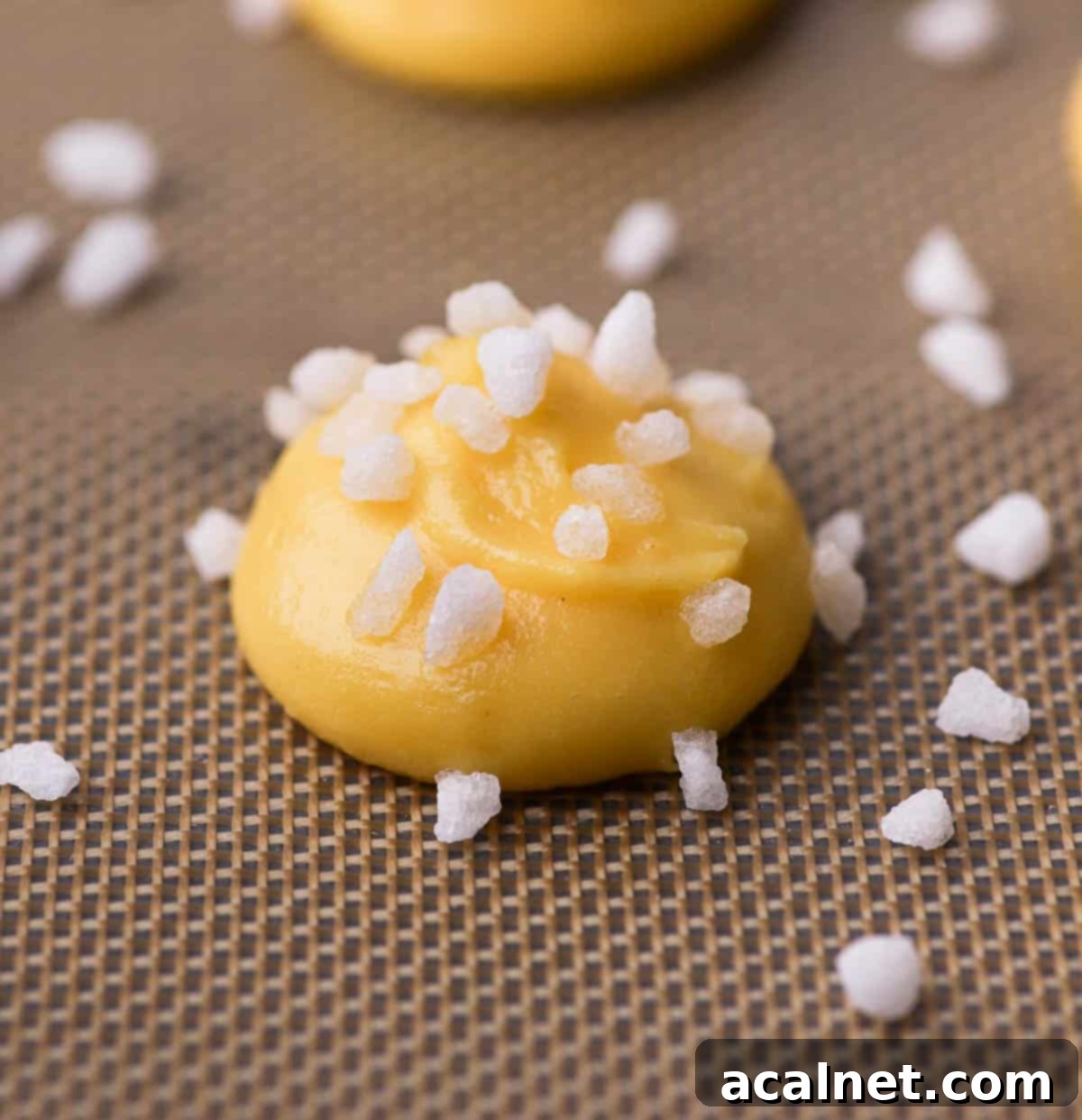
Common Chouquettes Issues and How to Fix Them
Even experienced bakers can encounter challenges with choux pastry. Here’s a guide to common troubleshooting scenarios:
- What is the right consistency for the dough?
As highlighted earlier, the precise amount of eggs needed will vary with each batch, and getting this consistency right is fundamental. To confirm you’ve achieved the perfect balance, gently poke a clean finger into the prepared dough. A small amount of the mixture should cling to your finger. Now, lift your finger and turn it upside down so the dough is standing upright. Observe if the dough slowly yields, curving downward to form an inverted ‘C’ or a soft ‘beak’ shape.If the dough remains stiff and stands completely upright without any curve, it indicates that more egg is needed. Add a very small amount, mix, and re-test. Conversely, if the dough is too fluid and completely collapses (rather than forming a gentle curve), you’ve unfortunately added too many eggs. This is generally irreversible, so always add eggs incrementally and with caution.
- My Chouquettes aren’t rising. What went wrong?
Several factors can contribute to flat chouquettes:- Insufficiently dried dough: If the “panade” wasn’t cooked long enough on the stove, it retains too much moisture, preventing proper steam expansion and rise.
- Incorrect egg quantity: Both too little or too much egg can hinder rising. Too little makes the dough too stiff to expand; too much makes it too weak to hold its structure.
- Incorrect oven temperature: The oven needs to be hot enough to create an immediate burst of steam, which is what causes the choux to puff up. Ensure your oven is accurately calibrated.
- The sugar puffs collapsed after baking. Why?
Chouquettes typically collapse when they haven’t been baked for a sufficient duration, or if the oven temperature was not ideal, leaving too much moisture inside. The magic of choux pastry relies on the water and eggs turning into steam, which inflates the dough. This steam then needs time to evaporate and for the pastry walls to dry out and form a strong, stable crust. If removed from the oven too early, before this structure is set, the steam condenses, and the soft walls can’t support themselves, leading to a deflated puff. Resist the urge to open the oven door frequently! - My choux pastry puffs are getting soggy after a while. How can I prevent this?
Unfortunately, choux pastries are prone to absorbing moisture from the air, which inevitably leads to them becoming somewhat soggy over time. This is why they are unequivocally best enjoyed fresh, ideally on the day they are baked. To prolong their crispiness slightly, store them at room temperature in an airtight container for a very short period. Avoid storing them in the refrigerator unless they are filled with cream, as the fridge environment contains too much moisture and will accelerate softening.
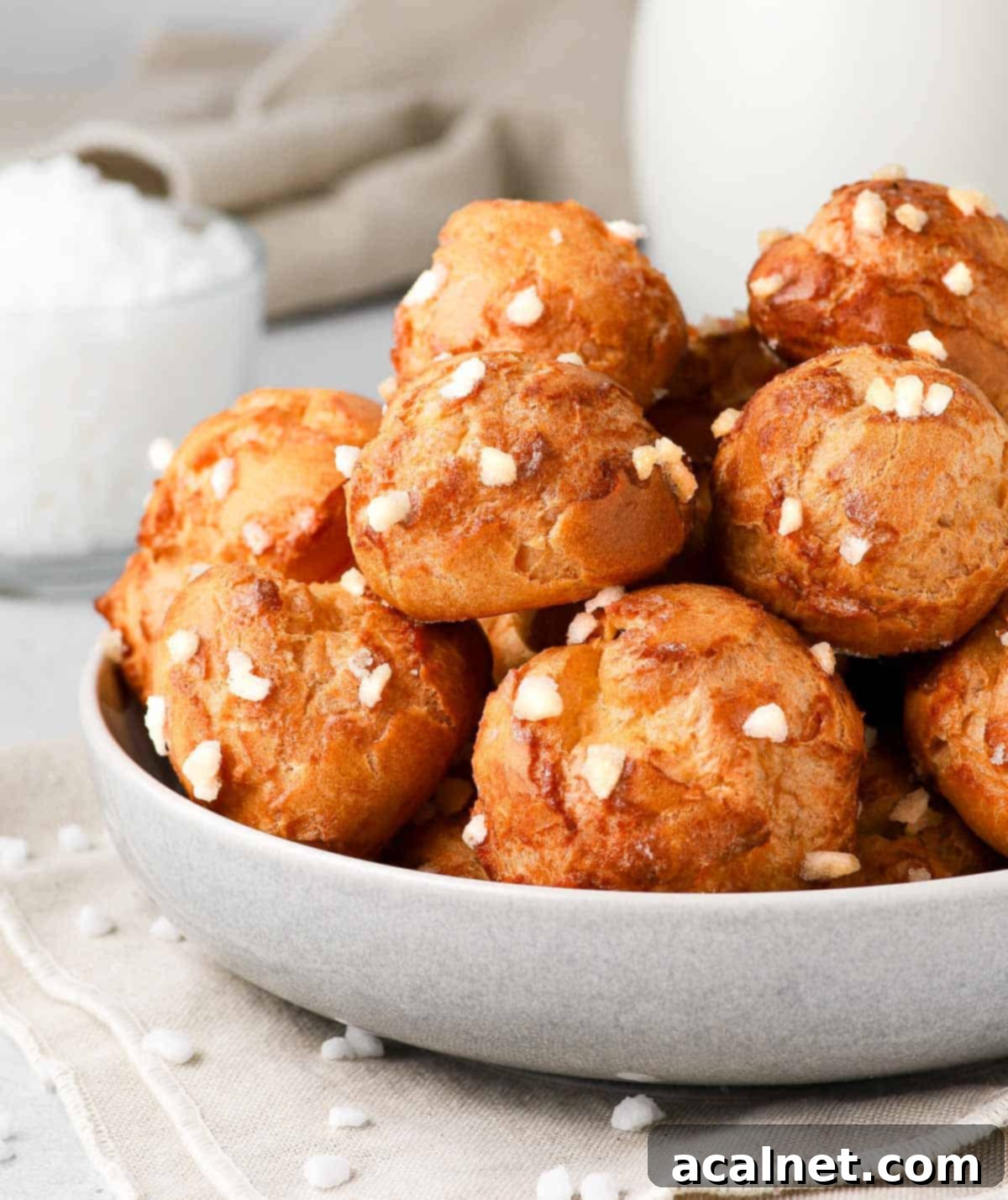
Top Tips for Perfect Chouquettes Every Time
Achieving bakery-quality Chouquettes at home is entirely possible with a few key considerations. Follow these expert tips to ensure your French sugar puffs are a resounding success:
- Mastering the Eggs: The quantity of eggs needed for choux pastry is rarely exact and can vary slightly with each batch due to factors like flour type and humidity. It’s imperative to add the whisked eggs gradually, a little at a time, mixing thoroughly after each addition, until you reach the perfect “beak” consistency. You might use slightly more or less than the recipe specifies, so trust the visual cue over strict measurements for this step.
- Be Generous with Pearl Sugar: Don’t be shy when sprinkling the pearl sugar! These choux buns will expand significantly during baking, and some of the sugar will inevitably fall off. A liberal application ensures that each Chouquette emerges from the oven with a delightfully crunchy, sweet coating.
- Bake Them Long Enough (and Resist Opening the Oven!): This is perhaps the most critical tip for preventing collapsed chouquettes. Choux pastry needs to bake sufficiently long to dry out the interior and form a stable, crisp crust. When they look golden, give them an extra 5-10 minutes. Only open the oven door *once* for a brief second (usually toward the end of the baking time) to release steam. Opening the oven prematurely or too frequently will cause a sudden drop in temperature, leading to immediate deflation.
- Bake in Batches if Needed: If your choux pastry mixture yields more than what comfortably fits on a single baking tray, pipe the remainder onto a second tray. Bake each batch separately. Overcrowding the oven can interfere with proper air circulation and steam release, resulting in unevenly baked or less puffed chouquettes.
Storing & Freezing Chouquettes
For the ultimate fresh experience, these delicate Sugar Puffs are truly best enjoyed immediately after they have cooled. Their light, crispy texture is at its peak right out of the oven.
If you must store them, keep plain chouquettes at room temperature in an airtight container for no more than a day. Any longer, and they will begin to absorb moisture from the air, losing their signature crispness and becoming somewhat soggy.
Should you decide to fill your chouquettes with cream, it’s highly recommended to add the filling just before serving. Filling them too early will cause the choux pastry to become soggy as it absorbs moisture from the cream. Once filled, any leftovers must be stored in the refrigerator due to the perishable nature of the cream.
Chouquettes can be frozen, and choux pastry generally freezes quite well. To freeze, arrange plain, cooled chouquettes on a baking sheet and freeze until solid. Then transfer them to an airtight freezer-safe bag or container for up to 1 month. When you’re ready to enjoy them, thaw them at room temperature for a few hours. Keep in mind that frozen and thawed chouquettes might be a little softer than freshly baked ones. You can often revive some of their crispiness by reheating them in a preheated oven at 150°C (300°F) for 5-10 minutes.
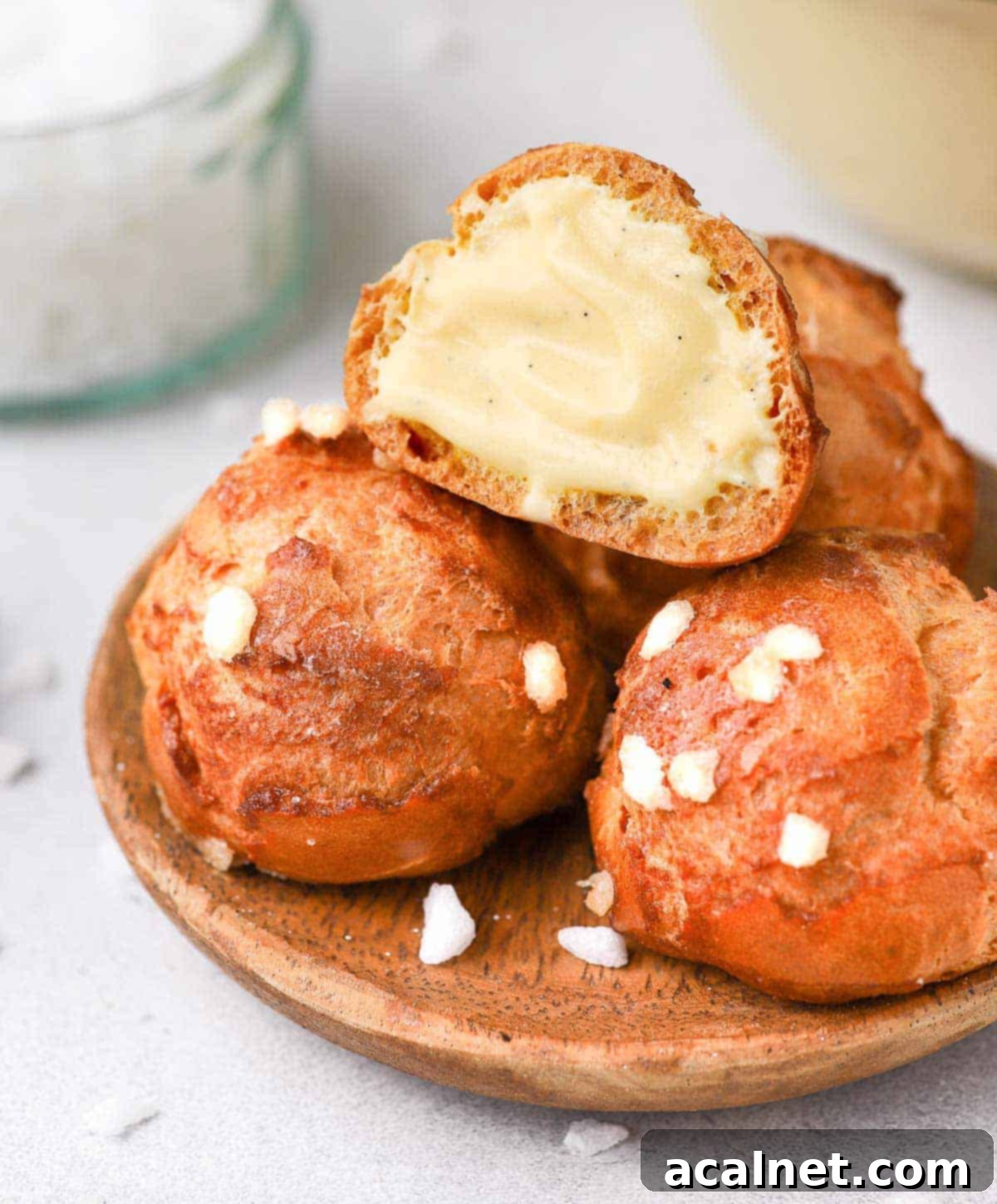
Explore More French Treats
If you’ve enjoyed making these delightful Chouquettes, we invite you to continue your culinary journey through French patisserie with these other fantastic recipes:
- Irresistible Chocolate Orange Tartlets
- Elegant Coffee Financiers
- Zesty Lemon Curd Tartlets
- Bright Mini Orange Tarts
- Fluffy Brioche Donuts
- Delicate Almond Raspberry Madeleines
- Rich Mini Chocolate Tarts
- Caramelized Cannelés de Bordeaux
- Decadent Chocolate Financiers
Made this recipe?
We’d love to hear from you! Let us know if you liked it by leaving a comment below. Share your delicious creations and tag us on Instagram @a.baking.journey with a photo!
Recipe Card: Classic Chouquettes (French Sugar Puffs)

Chouquettes (French Sugar Puffs)
Servings:
25
Author:
Sylvie
20 minutes
35 minutes
55 minutes
Print Recipe
Prevent your screen from going dark
Ingredients
- 125 ml (1/2 cup) Water
- 60 gr (1/4 cup) Unsalted Butter
- 15 gr (1 tablespoon) Caster Sugar, or fine white granulated sugar
- 75 gr (1/2 cup) Plain / AP Flour
- 2 Eggs, at room temperature, see note below
- 100 gr (3/4 cup) Pearl Sugar, or to taste
Instructions
- Preheat your oven on 180’C/350’F. Prepare a large baking tray with a baking mat or paper.
- Place the Water, Butter and Sugar and a medium size saucepan. Heat up on medium heat until all the butter and sugar has dissolved.
- Away from the heat, drop in the sifted Flour at once. Stir with a wooden spoon or stiff spatula until a dough starts to form. Place back on medium heat and keep stirring for a few minutes to dry out the dough as much as possible (see note 1).
- Transfer into the bowl of your mixer (or a mixing bowl if making by hands/with a hand mixer) fitted with the paddle attachment. Leave to cool down for 10 minutes.
- In a separate bowl, whisk the eggs. Add the whisked eggs a little bit at the time, mixing until the mixture is smooth before adding more (see note 2). Keep on adding the eggs until you get a soft, shiny and supple pastry. You may need more or less egg than recommended (see note 3).
- Transfer the choux pastry in a pastry bag fitted with a large round piping tip. Pipe small mounds of pastry over the prepared baking tray , leaving some space between each chouquette as they will expand.
- Generously sprinkle some pearl sugar over each chouquette.
- Bake for 25 minutes, open the oven door for one second to let the steam out then close it off straight away. Bake for an additional 10 to 15 minutes, or until the chouquettes are puffed and golden (see note 4).
- Take out of the oven and leave to cool down completely on the baking tray. Serve straight away.
Video
Would you like to save this recipe?
We’ll email this post to you, so you can come back to it later!
Notes
- Eggs: Depending in the size of your eggs, how dry the dough is and the brand of flour you use, you might need a little bit more or less Eggs. Add the eggs a little bit at the time until you get the desired consistency.
- Pearl Sugar: you can find some online, in speciality shops or make your own by crushing sugar cubes.
Instruction Notes:
- The dough (called “panade” at this points) is ready when you can see a thin skin at the bottom of the saucepan and the dough does not stick to the saucepan anymore. A good way to dry out the dough as much as possible is to press it against the sides of the pan in a rotating movement.
- It will look like the dough is splitting every time you add some eggs, it’s normal! It will eventually come back together, just keep on mixing.
- The exact amount of eggs needed will depend on the brand of flour and how dry the dough got on the stove. To know you’ve got the right consistency, poke a finger into the dough and lift it (a little bit of dough should stick to the finger). Turn the finger upside down so that the dough is standing up, then look to see if the dough is slowly falling back down, creating an inverted ‘C’ shape. If the dough stands up without falling back at all, you need to add more eggs. Make sure to add the eggs a little bit at the time to avoid adding too much; you cannot save a choux pastry that has too much eggs and is too liquid.
- The exact baking time might vary based on the size of the chouquettes. Make sure not to open the oven door too early or more than once or the chouquettes might collapse.
Nutrition (per serving)
Carbohydrates: 7g |
Protein: 1g |
Fat: 2g |
Saturated Fat: 1g |
Polyunsaturated Fat: 1g |
Monounsaturated Fat: 1g |
Trans Fat: 1g |
Cholesterol: 18mg |
Sodium: 6mg |
Potassium: 9mg |
Fiber: 1g |
Sugar: 5g |
Vitamin A: 79IU |
Calcium: 3mg |
Iron: 1mg
